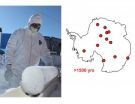(Press-News.org) Babies' growth in the womb and their size at birth, especially their length, are strikingly similar the world over – when babies are born to healthy, well-educated and well-nourished mothers.
That's the finding of a landmark international study, INTERGROWTH-21st, led by Oxford University researchers, which involved almost 60,000 pregnancies in eight defined urban areas in Brazil, China, India, Italy, Kenya, Oman, the UK and USA.
Worldwide there are wide disparities in the average size of babies at birth. This has significant consequences for future health, as small for gestational age babies who are already undernourished at birth often face severe short- and long-term health consequences.
It has previously been suggested that 'race' and 'ethnicity' are largely responsible for differences in the size of babies born in different populations and countries. These new results show that race and ethnicity are not the primary factors. What matters more is the educational, health and nutritional status of the mothers, and care provided during pregnancy.
The researchers carried out ultrasound scans from early pregnancy to delivery to measure babies' bone growth in the womb, using identical methods in all countries and the same ultrasound machines provided by Philips Healthcare. They also measured the length and head circumference of all babies at birth.
They have demonstrated that if mothers' educational, health and nutritional status and care during pregnancy are equally good, babies will have equal chances of healthy growth in the womb and future good health.
The researchers report their findings in The Lancet, Diabetes & Endocrinology. They were funded by the Bill & Melinda Gates Foundation.
'Currently we are not all equal at birth. But we can be,' said the lead author Professor Jose Villar of the Nuffield Department of Obstetrics & Gynaecology, University of Oxford. 'We can create a similar start for all by making sure mothers are well educated and nourished, by treating infection and by providing adequate antenatal care.
'Don't tell us nothing can be done. Don't say that women in some parts of the world have small children because they are predestined to do so. It's simply not true.'
Key points
The study involved almost 60,000 pregnancies in eight defined urban areas in Brazil, China, India, Italy, Kenya, Oman, the UK and USA.
Babies' bone growth in the womb and their length and head circumference at birth are strikingly similar the world over – when babies are born to educated, healthy and well-nourished mothers.
Overall, no more than 4% of the total difference in fetal growth and birth size could be attributed to differences between the eight populations in the study.
Improving the education, health and nutrition of mothers everywhere will boost the health of their babies throughout life within the next generation.
Results are in complete agreement with the previous WHO study using the same methodology from birth to 5 years of age.
In 2010, an estimated 32.4 million babies were born already undernourished in low- and middle-income countries, which represents 27% of all live births globally. This is closely associated with illness and death in infancy and childhood. Small size at birth has an impact on adult health too, with increased risks of diabetes, high blood pressure and cardiovascular disease. Smaller babies also result in substantial costs for health services and a significant economic burden on societies as a whole.
Part of the problem in starting to improve pregnancy outcomes is that fetal growth and newborn size are currently evaluated in clinics around the world using at least 100 different growth charts. In other words, there are no international standards at present for the fetus and newborn, while such standards do exist for infants and children.
'This is very confusing for doctors and mothers and makes no biological sense. How can a fetus or a newborn be judged small in one clinic or hospital and treated accordingly, only for the mother to go to another city or country, and be told that her baby is growing normally,' said Professor Stephen Kennedy, University of Oxford, one of the senior authors of the paper.
The final aim of the INTERGROWTH-21st study is to construct international standards describing optimal growth of a baby in the womb and as a newborn – standards to reflect how a baby should grow when mothers have adequate health, nutrition and socioeconomic status.
The researchers adopted the same approach taken by the WHO's Multicentre Growth Reference Study of healthy infants and children, which established international growth standards from birth to 5 years of age that are now used in more than 140 countries worldwide.
The INTERGROWTH-21st results fit perfectly with the existing WHO standards for infants. The mean length at birth of the newborns in the INTERGROWTH-21st study was 49.4 ± 1.9 cm, compared with 49.5 ±1.9 cm in the WHO infant study.
From now on international standards can be used worldwide to make judgements on growth and size from conception to 5 years. 'Just think, if your cholesterol or your blood pressure are high, they are high regardless of where you live. Why should the same not apply to growth?' said Professor Villar.
Professor Ruyan Pang, from Peking University, China, one of the study's lead investigators, said: 'The INTERGROWTH-21st results fit perfectly with the existing WHO Infant and Child Growth Standards. Having international standards of optimal growth from conception to 5 years of age that everyone in the world can use means it will now be possible to evaluate improvements in health and nutrition using the same yardstick.'
Professor Zulfiqar Bhutta, from The Aga Khan University, Karachi, Pakistan and the Hospital for Sick Children, Toronto, Canada, who is the Chair of the Steering Committee of this global research team, says: 'The fact that when mothers are in good health, babies grow in the womb in very similar ways the world over is a tremendously positive message of hope for all women and their families. But there is a challenge as well. There are implications in terms of the way we think about public health: This is about the health and life chances of future citizens everywhere on the planet. All those who are responsible for health care will have to think about providing the best possible maternal and child health.'
INFORMATION:
Notes to Editors
The paper 'The likeness of fetal growth and newborn size across non-isolated populations in the INTERGROWTH-21st Project' is to be published in The Lancet Diabetes & Endocrinology with an embargo of 00:01 UK time on Monday 7 July 2014 / 19:01 US Eastern time on Sunday 6 July 2014.
The study was funded by the Bill & Melinda Gates Foundation.
A number of factors can lead to small babies, such as mothers' poor nutrition and health over a long period, infections, complications during pregnancy, smoking, alcohol, physically demanding work during pregnancy and the baby's premature birth.
Overnutrition is also becoming a problem because of rising rates of obesity that result in more large babies being born.
The scale of the project is unprecedented in this area. It involved the recruitment of almost 60,000 women, the standardisation of clinical practice of 300 health professionals across eight study sites, the careful monitoring of equipment and data to ensure accuracy, and a team of over 200 researchers and clinicians.
As well as the lead authors from Oxford University, the international research team included members from Peking University in China, the Universidade Católica de Pelotas in Brazil, the Aga Khan University in Kenya, the Ministry of Health in Oman, the Università degli Studi di Torino in Italy, the University of Washington School of Medicine and the Swedish Medical Centre, Seattle in the USA, and the Ketkar Hospital in Nagpur, India.
Oxford University's Medical Sciences Division is one of the largest biomedical research centres in Europe, with over 2,500 people involved in research and more than 2,800 students. The University is rated the best in the world for medicine, and it is home to the UK's top-ranked medical school.
From the genetic and molecular basis of disease to the latest advances in neuroscience, Oxford is at the forefront of medical research. It has one of the largest clinical trial portfolios in the UK and great expertise in taking discoveries from the lab into the clinic. Partnerships with the local NHS Trusts enable patients to benefit from close links between medical research and healthcare delivery.
A great strength of Oxford medicine is its long-standing network of clinical research units in Asia and Africa, enabling world-leading research on the most pressing global health challenges such as malaria, TB, HIV/AIDS and flu. Oxford is also renowned for its large-scale studies, which examine the role of factors such as smoking, alcohol and diet on cancer, heart disease and other conditions.
Babies born to healthy mums worldwide are strikingly similar in size
Poor nutrition and health, not race or ethnicity, cause most of the current wide disparities in fetal growth and newborn size
2014-07-07
ELSE PRESS RELEASES FROM THIS DATE:
Researchers uncover new knowledge about our intestines
2014-07-06
Researchers from DTU Systems Biology have mapped 500 previously unknown microorganisms in human intestinal flora as well as 800 also unknown bacterial viruses (also called bacteriophages) which attack intestinal bacteria.
To map the microorganisms, the researchers have developed a new principle for analysing DNA sequence data, which they have named the co-abundance principle. A principle which basically assumes that different pieces of DNA from the same organism will occur in the same amount in a sample, and that this amount will vary over a series of samples.
"Using ...
'Nanojuice' could improve how doctors examine the gut
2014-07-06
BUFFALO, N.Y. – Located deep in the human gut, the small intestine is not easy to examine. X-rays, MRIs and ultrasound images provide snapshots but each suffers limitations.
Help is on the way.
University at Buffalo researchers are developing a new imaging technique involving nanoparticles suspended in liquid to form "nanojuice" that patients would drink. Upon reaching the small intestine, doctors would strike the nanoparticles with a harmless laser light, providing an unparalleled, non-invasive, real-time view of the organ.
Described July 6 in the journal Nature Nanotechnology, ...
Discovery provides insights on how plants respond to elevated CO2 levels
2014-07-06
Biologists at UC San Diego have solved a long-standing mystery concerning the way plants reduce the numbers of their breathing pores in response to rising carbon dioxide levels in the atmosphere.
In a paper published in this week's early online edition of Nature, they report the discovery of a new genetic pathway in plants, made up of four genes from three different gene families that control the density of breathing pores—or "stomata"—in plant leaves in response to elevated CO2 levels.
Their discovery should help biologists better understand how the steadily increasing ...
Rewriting the history of volcanic forcing during the past 2,000 years
2014-07-06
RENO – A team of scientists led by Michael Sigl and Joe McConnell of Nevada's Desert Research Institute (DRI) has completed the most accurate and precise reconstruction to date of historic volcanic sulfate emissions in the Southern Hemisphere.
The new record, described in a manuscript published today in the online edition of Nature Climate Change, is derived from a large number of individual ice cores collected at various locations across Antarctica and is the first annually resolved record extending through the Common Era (the last 2,000 years of human history).
"This ...
Global toolkit to diagnose menopause
2014-07-06
Created at Monash University, the world's first toolkit is designed for GPs to use with women from the age of 40. Thought to be the first of its kind, researchers say the toolkit has the potential to help manage menopausal conditions for women globally.
The Practitioner Toolkit for Managing the Menopause, which includes a diagnostic tool, as well as a compendium of approved hormone therapies, is published today in the journal, Climacteric.
Led by Professor Susan Davis, the research team from the School of Public Health and Preventative Medicine, combined existing research ...
The Lancet: Sierra Leone researchers call for improved health surveillance and communication around Ebola crisis
2014-07-05
Researchers working in Sierra Leone today [Saturday 5 July] suggest priority actions needed to tackle the ongoing Ebola crisis in West Africa. In a letter to The Lancet, the researchers call for improvements in access to diagnostic technologies and health-care resources, as well as improved disease surveillance and health communication.
At present, there is little incentive for patients to seek professional diagnosis of suspected Ebola, say the authors, with most people with febrile (fever-causing) illnesses in Sierra Leone treated at home, and the true extent of the ...
The Lancet: New trial suggests cheaper drugs for common heart attack procedure could improve outcomes and save health budgets millions
2014-07-05
A new study published in The Lancet compares outcomes for two drugs used to prevent blood clot formation during emergency heart attack treatment. The study suggests that use of one of the drugs, heparin, could result in improved outcomes (such as a reduced rate of repeat heart attacks), compared to the other drug tested, bivalirudin, which is in widespread use in high-income countries, and is around 400 times more expensive than heparin.
The results of the HEAT-PPCI trial suggest that systematic use of heparin rather than bivalirudin after primary percutaneous coronary ...
Association found between high cholesterol and breast cancer
2014-07-04
This news release is available in Spanish.
Barcelona, 4 July 2014: An association between high blood cholesterol and breast cancer has been found in a study of more than 1 million patients over a 14 year time period in the UK. The research will be presented today at Frontiers in CardioVascular Biology (FCVB) 2014 in Barcelona, Spain. The meeting is organised by the Council on Basic Cardiovascular Science of the European Society of Cardiology (ESC) in collaboration with 13 European cardiovascular science societies.
http://spo.escardio.org/SessionDetails.aspx?eevtid=65&sessId=13301&subSessId=3494
Dr ...
First evidence for painless atrial fibrillation treatment
2014-07-04
Barcelona, 4 July 2014: The first evidence for a shockless treatment for atrial fibrillation (AF) will be presented today at Frontiers in CardioVascular Biology (FCVB) 2014 in Barcelona, Spain. The meeting is organised by the Council on Basic Cardiovascular Science of the European Society of Cardiology (ESC) in collaboration with 13 European cardiovascular science societies. http://spo.escardio.org/SessionDetails.aspx?eevtid=65&sessId=13104
Dr Brian O. Bingen, first author, said: "AF is the most common cardiac arrhythmia. Symptoms range from the feeling of fish flapping ...
Effects of conflict on women's reproductive health need to be managed sensitively
2014-07-04
Clinicians need to be sensitive and aware of the unique challenges of women's reproductive health needs in times of conflict, suggests a new review published today (4 July) in The Obstetrician & Gynaecologist (TOG).
Approximately 1.5 billion people are currently living in countries affected by conflict, fragility or large-scale violence. Women and children account for approximately 75% of those displaced by conflict and roughly 20% of those displaced are women of reproductive age and one in five will be pregnant.
This new review looks at how conflict can negatively ...
LAST 30 PRESS RELEASES:
New software sheds light on cancer’s hidden genetic networks
UT Health San Antonio awarded $3 million in CPRIT grants to bolster cancer research and prevention efforts in South Texas
Third symposium spotlights global challenge of new contaminants in China’s fight against pollution
From straw to soil harmony: International team reveals how biochar supercharges carbon-smart farming
Myeloma: How AI is redrawing the map of cancer care
Manhattan E. Charurat, Ph.D., MHS invested as the Homer and Martha Gudelsky Distinguished Professor in Medicine at the University of Maryland School of Medicine
Insilico Medicine’s Pharma.AI Q4 Winter Launch Recap: Revolutionizing drug discovery with cutting-edge AI innovations, accelerating the path to pharmaceutical superintelligence
Nanoplastics have diet-dependent impacts on digestive system health
Brain neuron death occurs throughout life and increases with age, a natural human protein drug may halt neuron death in Alzheimer’s disease
SPIE and CLP announce the recipients of the 2025 Advanced Photonics Young Innovator Award
Lessons from the Caldor Fire’s Christmas Valley ‘Miracle’
Ant societies rose by trading individual protection for collective power
Research reveals how ancient viral DNA shapes early embryonic development
A molecular gatekeeper that controls protein synthesis
New ‘cloaking device’ concept to shield sensitive tech from magnetic fields
Researchers show impact of mountain building and climate change on alpine biodiversity
Study models the transition from Neanderthals to modern humans in Europe
University of Phoenix College of Doctoral Studies releases white paper on AI-driven skilling to reduce burnout and restore worker autonomy
AIs fail at the game of visual “telephone”
The levers for a sustainable food system
Potential changes in US homelessness by ending federal support for housing first programs
Vulnerability of large language models to prompt injection when providing medical advice
Researchers develop new system for high-energy-density, long-life, multi-electron transfer bromine-based flow batteries
Ending federal support for housing first programs could increase U.S. homelessness by 5% in one year, new JAMA study finds
New research uncovers molecular ‘safety switch’ shielding cancers from immune attack
Bacteria resisting viral infection can still sink carbon to ocean floor
Younger biological age may increase depression risk in older women during COVID-19
Bharat Innovates 2026 National Basecamp Showcases India’s Most Promising Deep-Tech Ventures
Here’s what determines whether your income level rises or falls
SCIE indexation achievement: Celebrate with Space: Science & Technology
[Press-News.org] Babies born to healthy mums worldwide are strikingly similar in sizePoor nutrition and health, not race or ethnicity, cause most of the current wide disparities in fetal growth and newborn size



